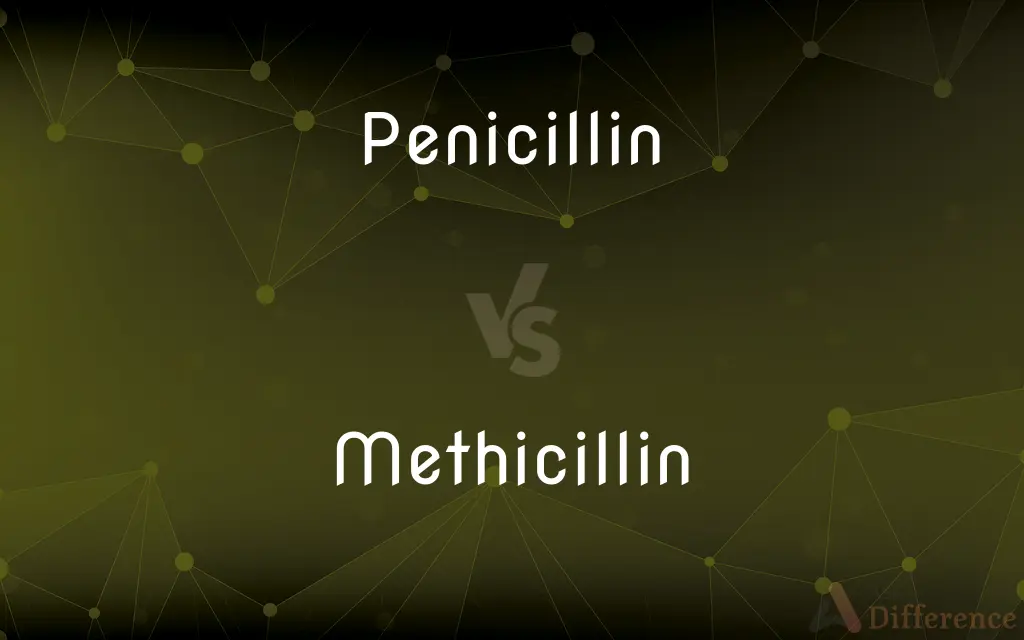Penicillin vs. Methicillin — What's the Difference?
By Tayyaba Rehman & Maham Liaqat — Updated on March 29, 2024
Penicillin is a broad-spectrum antibiotic effective against a wide range of bacteria, while methicillin, a derivative, is specifically designed to treat penicillin-resistant Staphylococcus aureus but is no longer in clinical use due to resistance.

Difference Between Penicillin and Methicillin
Table of Contents
ADVERTISEMENT
Key Differences
Penicillin, discovered in 1928, is one of the earliest antibiotics used to combat bacterial infections, effective against various gram-positive bacteria. It works by inhibiting the synthesis of the bacterial cell wall, leading to cell death. Methicillin, developed in 1959, was introduced as a penicillinase-resistant antibiotic to treat infections caused by penicillin-resistant Staphylococcus aureus, indicating a more targeted approach than its predecessor.
While penicillin has a broad spectrum of activity and is used to treat a wide variety of bacterial infections, methicillin was specifically designed to overcome resistance in certain strains of bacteria. However, the emergence of methicillin-resistant Staphylococcus aureus (MRSA) has made methicillin and its derivatives less effective, leading to their decreased use in clinical settings.
Penicillin’s side effects generally include allergic reactions, ranging from mild rashes to severe anaphylaxis, affecting a notable percentage of the population. Methicillin, on the other hand, has been associated with more serious side effects, including nephrotoxicity (kidney damage), limiting its use even before resistance became widespread.
The use of penicillin is widespread in both human and veterinary medicine, attributed to its effectiveness and relatively low cost. Methicillin’s use has been significantly reduced due to the development of MRSA, with healthcare professionals opting for newer antibiotics to treat such infections.
The discovery of penicillin revolutionized the treatment of bacterial infections, significantly reducing the mortality rate associated with such infections. Methicillin represents an important step in the ongoing battle against bacterial resistance but also highlights the challenges of developing antibiotics that can keep pace with evolving bacterial defenses.
ADVERTISEMENT
Comparison Chart
Spectrum
Broad-spectrum, effective against various bacteria
Narrow-spectrum, designed for penicillin-resistant Staphylococcus aureus
Discovery Year
1928
1959
Primary Use
Treating a wide range of bacterial infections
Treating infections caused by penicillin-resistant bacteria
Side Effects
Allergic reactions, ranging from mild to severe
Nephrotoxicity, allergic reactions
Current Clinical Use
Widely used in human and veterinary medicine
Limited use due to resistance (MRSA)
Compare with Definitions
Penicillin
A broad-spectrum antibiotic for treating bacterial infections.
Penicillin is often prescribed for strep throat.
Methicillin
Designed to treat penicillin-resistant Staphylococcus aureus.
Methicillin was once the go-to antibiotic for MRSA infections.
Penicillin
It inhibits bacterial cell wall synthesis.
The mode of action of penicillin disrupts bacteria's cell walls, causing them to burst.
Methicillin
Introduced as a penicillinase-resistant antibiotic.
Methicillin was developed to counteract bacteria that had evolved resistance to penicillin.
Penicillin
Revolutionized the treatment of bacterial infections.
The introduction of penicillin drastically reduced deaths from bacterial infections.
Methicillin
Represents the challenge of antibiotic resistance.
The case of methicillin underscores the ongoing battle against bacterial resistance.
Penicillin
Known for its effectiveness against gram-positive bacteria.
Penicillin effectively treats infections caused by Streptococcus pneumoniae.
Methicillin
Its use has been curtailed due to MRSA resistance.
The emergence of MRSA has led to the discontinuation of methicillin in clinical settings.
Penicillin
Can cause allergic reactions in some individuals.
She carried an epinephrine auto-injector due to her penicillin allergy.
Methicillin
Associated with nephrotoxicity.
Methicillin use is limited due to its potential to cause kidney damage.
Penicillin
Penicillins (P, PCN or PEN) are a group of antibiotics originally obtained from Penicillium moulds, principally P. chrysogenum and P. rubens. Most penicillins in clinical use are chemically synthesised from naturally-produced penicillins.
Methicillin
Methicillin, also known as meticillin, is a narrow-spectrum β-lactam antibiotic of the penicillin class. Meticillin was discovered in 1960.
Penicillin
An antibiotic drug obtained from molds especially of the genus Penicillium or produced synthetically, available in various preparations and usually used to treat infections caused by gram-positive bacteria.
Methicillin
A semisynthetic penicillin, C17H20N2O6S, formerly used in the form of its sodium salt to treat infections caused by penicillinase-producing staphylococci.
Penicillin
Any of a group of broad-spectrum antibiotic drugs, synthetic or semisynthetic, that are derived from penicillin.
Methicillin
(pharmaceutical drug) meticillin.
Penicillin
(pharmaceutical drug) Any of a group of narrow-spectrum antibiotics obtained from Penicillium molds or synthesized, that have a beta-lactam structure and are active against gram-positive bacteria and used in the treatment of various infections and diseases.
Methicillin
Antibiotic drug of the penicillin family used in the treatment of certain staphylococcal infections
Penicillin
(mycology) A blue mold of the genus Penicillium that produces penicillin.
Penicillin
Any of a variety of substances having a structure containing a beta-lactam ring fused to a thiirane ring, to which a carboxyl group is attached, but most commonly interpreted as benzyl penicillin. They are notable as powerful antibacterial agents of relatively low toxicity which have found extensive use in medicine for treating bacterial infections. They are categorized as one of the classes of beta-lactam antibiotic. They are produced naturally by some fungi and bacteria, and industrial production processes almost invariably start from some form of the penicillin nucleus produced by fermentation of microorganisms. The fermentation products are then chemically modified to produce derivatives of enhanced potency, safety, or antibacterial spectrum. The first penicillin to see extensive use clinically (during World War II) was penicillin G, also called benzypenicillin, and commonly simply "penicillin".
Penicillin
Any of various antibiotics obtained from penicillium molds (or produced synthetically) and used in the treatment of various infections and diseases
Common Curiosities
Can people be allergic to penicillin and methicillin?
Yes, individuals can be allergic to both penicillin and methicillin, with reactions ranging from mild to severe.
What is penicillin?
Penicillin is a broad-spectrum antibiotic used to treat various bacterial infections.
What is methicillin?
Methicillin is an antibiotic designed to treat infections caused by penicillin-resistant Staphylococcus aureus.
Are there alternatives to methicillin for treating MRSA?
Yes, there are newer antibiotics available that are effective against MRSA.
What are the side effects of penicillin?
Penicillin’s side effects mainly include allergic reactions.
What led to the development of methicillin?
Methicillin was developed in response to the increasing incidence of bacterial resistance to penicillin.
How do penicillin and methicillin differ in their spectrum of activity?
Penicillin has a broad spectrum of activity, while methicillin is more targeted towards penicillin-resistant bacteria.
How did the discovery of penicillin impact healthcare?
The discovery of penicillin significantly reduced the mortality rate associated with bacterial infections.
Why is methicillin no longer widely used?
Methicillin is no longer widely used due to the emergence of MRSA, which is resistant to this antibiotic.
Is penicillin still effective today?
Yes, penicillin remains effective against a wide range of bacterial infections.
Why was methicillin developed?
Methicillin was developed to treat bacterial infections that had become resistant to penicillin.
What measures can be taken to prevent antibiotic resistance?
Measures include using antibiotics judiciously and only when prescribed by a healthcare professional.
What are the side effects of methicillin?
Methicillin’s use is associated with nephrotoxicity and allergic reactions.
How do healthcare providers choose between penicillin and other antibiotics?
The choice between penicillin and other antibiotics depends on the type of infection, presence of allergies, and potential resistance patterns.
How does antibiotic resistance affect the use of methicillin?
Antibiotic resistance, especially MRSA, has limited the use of methicillin in treating bacterial infections.
Share Your Discovery

Previous Comparison
Devaluation vs. Inflation
Next Comparison
Consul vs. AmbassadorAuthor Spotlight
Written by
Tayyaba RehmanTayyaba Rehman is a distinguished writer, currently serving as a primary contributor to askdifference.com. As a researcher in semantics and etymology, Tayyaba's passion for the complexity of languages and their distinctions has found a perfect home on the platform. Tayyaba delves into the intricacies of language, distinguishing between commonly confused words and phrases, thereby providing clarity for readers worldwide.
Co-written by
Maham Liaqat














































